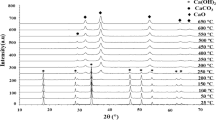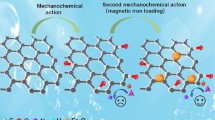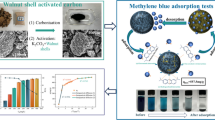Abstract
Hexavalent chromium is widely used in industry and causes human health and environmental problems due to its extremely toxic properties. On the contrary, trivalent chromium is necessary for living ecosystems. Therefore, reducing hexavalent chromium to trivalent chromium is the best strategy for detoxifying hexavalent chromium. Pd(0)@C nanocatalyst was prepared by a simple impregnation-reduction method in solution under mild conditions at 298 K and was identified by XPS, XRD, TEM, TEM–EDX, HR-TEM, and ICP-OES analyses. TEM results showed that very well-dispersed Pd nanoparticles were formed on the C surface (mean particle sizes 3.98 ± 0.24 nm). The catalytic performance of Pd(O)NPs impregnated on cheap and easily available commercial activated carbon were tested as heterogeneous nanocatalysts in the catalytic reduction of hexavalent chromium in the medium of formic acid, which is a good reducing agent, and sodium formate as the promoter at 298 K. It was determined that the formed Pd(0) nanoclusters could successfully reduce Cr(VI) to Cr(III) with high selectivity (~ 97%) in formic acid and sodium formate solution under mild conditions. It was also observed that the Pd(0)@C catalyst retained a significant (> 75%) initial activity even after the 5th use. In addition, the kinetic studies of the catalytic reduction reaction of Cr(VI) catalyzed by Pd(0)@C nanoparticles were investigated depending on the substrate [Cr2O72−], catalyst [Pd(0)@C], sodium formate [HCOONa], formic acid [HCOOH] concentrations, and temperature parameter. From the rich kinetic data obtained, the nature of the velocity equation was explained, and the activation parameters were calculated.








Similar content being viewed by others
Data Availability
All data generated or analyzed during this study are included in this published article and its supplementary information files.
References
Abass, E., Alireza, M., & Reza, V. (2005). Chromium (III) removal and recovery from tannery wastewater by precipitation process. American Journal of Applied Sciences, 2(10), 1471–1473. https://doi.org/10.3844/ajassp.2005.1471.1473
Barakat, T., Rooke, J. C., Genty, E., Cousin, R., Siffert, S., & Su, B. L. (2013). Gold catalysts in environmental remediation and water-gas shift technologies. Energy & Environmental Science, 6(2), 371–391. https://doi.org/10.1039/c2ee22859a
Bertoni, F. A., Bellu, S. E., Gonzalez, J. C., & Sala, L. F. (2014). Reduction of hypervalent chromium in acidic media by alginic acid. Carbohydrate Polymers, 114, 1–11. https://doi.org/10.1016/j.carbpol.2014.07.065
Buerge, I. J., & Hug, S. J. (1998). Influence of organic ligands on chromium(VI) reduction by iron(II). Environmental Science and Technology, 32(14), 2092–2099. https://doi.org/10.1021/es970932b
Bulut, A., Yurderi, M., Karatas, Y., Zahmakiran, M., Kivrak, H., Gulcan, M., & Kaya, M. (2015). Pd-MnOx nanoparticles dispersed on amine-grafted silica: Highly efficient nanocatalyst for hydrogen production from additive-free dehydrogenation of formic acid under mild conditions. App. Catal. b: Environ., 164, 324–333. https://doi.org/10.1016/j.apcatb.2014.09.041
Celebi, M., Yurderi, M., Bulut, A., Kaya, M., & Zahmakiran, M. (2016). Palladium nanoparticles supported on amine-functionalized SiO2 for the catalytic hexavalent chromium reduction. Applied Catalysis b: Environmental, 180, 53–64. https://doi.org/10.1016/j.apcatb.2015.06.020
Chauhan, D., Jaiswal, M., & Sankararamakrishnan, N. (2012). Removal of cadmium and hexavalent chromium from electroplating waste water using thiocarbamoyl chitosan. Carbohydrate Polymers, 88, 670–675. https://doi.org/10.1016/j.carbpol.2012.01.014
Chen, J. H., Hsu, K. C., & Chang, Y. M. (2013). Surface modification of hydrophobic resin with tri capryl methylammonium chloride for the removal of trace hexavalent chromium. Industrial and Engineering Chemistry Research, 52(33), 11685–11694. https://doi.org/10.1021/ie401233r
Chen, Z.-F., Zhao, Y.-S., & Li, Q. (2016). Influence of Fe(III) on Cr(VI) Reduction by organic reducing substances from sugarcane molasses. Water, Air, and Soil Pollution, 227, 19. https://doi.org/10.1007/s11270-015-2678-x
Dandapat, A., Jana, D., & De, G. (2011). Pd nanoparticles supported mesoporous γ-Al2O3 film as a reusable catalyst for reduction of toxic Cr(VI) to Cr(III) in aqueous solution. Applied Catalysis, a: General, 396(1–2), 34–39. https://doi.org/10.1016/j.apcata.2011.01.032
Demir, E., Sen, B., & Sen, F. (2017). Highly efficient Pt nanoparticles and f-MWCNT nanocomposites-based counter electrodes for dye-sensitized solar cells. Nano-Structures & Nano-Objects, 11, 39–45. https://doi.org/10.1016/j.nanoso.2017.06.003
Demirbaş, Ö., Çalımlı, M. H., Demirkan, B., Alma, M. H., Nas, M. S., Khan, A., Asiri, A. M., & Şen, F. (2019). The kinetic parameters of adsorption of enzymes using carbon-based materials obtained from different food wastes. Bio Nano Science, 9, 749–757. https://doi.org/10.1007/s12668-019-00635-x
Doan, D. H., Kim, Y. J., Nguyen, T. M., Yoon, H. O., Oh, S. G., Jo, H. Y., & Lee, Y. J. (2015). Characterization of Cr sorption and reduction on TiO2: Batch and XPS studies. Water, Air, and Soil Pollution, 226, 2252. https://doi.org/10.1007/s11270-014-2252-y
Durap, F., Zahmakiran, M., & Ozkar, S. (2009). Water soluble laurate-stabilized rhodium(0) nanoclusters catalyst with unprecedented catalytic lifetime in the hydrolytic dehydrogenation of ammonia-borane. App. Catal. a: Gen., 369(1–2), 53–59. https://doi.org/10.1016/j.apcata.2009.08.031
Elliott, D. W., & Zhang, W. (2001). Field assessment of nanoscale bimetallic particles for groundwater treatment. Environmental Science and Technology, 35(24), 4922–4926. https://doi.org/10.1021/es0108584
Enthaler, S., Langermann, J. V., & T. (2010). Carbon dioxide and formic acid-the couple for environmental-friendly hydrogenstorage? Energy Environ. Sci., 3, 1207–1217. https://doi.org/10.1039/b907569k
Fernández, P. M., Figueroa, L. I. C., & Fariña, J. I. (2010). Critical influence of culture medium and Cr(III) quantification protocols on the interpretation of Cr(VI) bioremediation by environmental fungal isolates. Water, Air, and Soil Pollution, 206, 283–293. https://doi.org/10.1007/s11270-009-0105-x
Fu, G. T., Jiang, X., Wu, R., Wei, S. H., Sun, D. M., Tang, Y. W., Lu, T. H., & Chen, Y. (2014). Arginine-assisted synthesis and catalytic properties of single-crystalline palladium tetrapods. ACS Appl. Mater. Inter., 6(24), 22790–22795. https://doi.org/10.1021/am506965f
Gheju, M. (2011). Hexavalent chromium reduction with zero-valent iron (ZVI) in aquatic systems. Water, Air, and Soil Pollution, 222, 103–148. https://doi.org/10.1007/s11270-011-0812-y
Gu, X., Lu, Z.-H., Jiang, H.-L., Akita, T., & Xu, Q. (2011). Synergistic catalysis of metal-organic framework-immobilized Au-Pd nanoparticles in dehydrogenation of formic acid for chemical hydrogen storage. Journal of the American Chemical Society, 13(31), 1822–11825. https://doi.org/10.1021/ja200122f
Hashim, M. A., Mukhopadhyay, S., Sahu, J. N., & Sengupta, B. (2011). Remediation technologies for heavy metal contaminated groundwater. Journal of Environmental Management, 92(10), 2355–2388. https://doi.org/10.1016/j.jenvman.2011.06.009
Hsu, L. C., Wang, S. L., Lin, Y. C., Wang, M. K., Chiang, P. N., Liu, J. C., Kuan, W. H., Chen, C. C., & Tzou, Y. M. (2010). Cr(VI) Removal on fungal biomass of Neurospora crassa: The importance of dissolved organic carbons derived from the biomass to Cr(VI) reduction. Environmental Science and Technology, 44(16), 6202–6208. https://doi.org/10.1021/es1017015
Huang, Y., Ma, H., Wang, S., Shen, M., Guo, R., Cao, X., Zhu, M., & Shi, X. (2012). Efficient catalytic reduction of hexavalent chromium using palladium nanoparticle-immobilized electrospun polymer nanofibers. ACS Appl. Mater. Inter., 4(6), 3054–3061. https://doi.org/10.1021/am300417s
Jiang, M., Qi, Y., Cui, Y.-L., Zhao, L., & Liu, S. (2017). Removal and recovery of chromium from aqueous solutions by reduction-absorption microreactor. Water, Air, and Soil Pollution, 228, 26. https://doi.org/10.1007/s11270-016-3203-6
, Joint Committee on Powder Diffraction Standards (1991), JCPDS International Center for Diffraction Data, Pennsylvania.
Keith, L. H., & Telliard, W. A. (1979). ES&T Special Report: Priority pollutants: I-a perspective view. Environmental Science and Technology, 13(4), 416–423. https://doi.org/10.1021/es60152a601
Kim, S. M., Lee, Y. J., Kim, J. W., & Lee, S. Y. (2014). Facile synthesis of Pt-Pd bimetallic nanoparticles by plasma discharge in liquid and their electrocatalytic activity toward methanol oxidation in alkaline media. Thin Solid Films, 572, 260–265. https://doi.org/10.1016/j.tsf.2014.07.067
Köktürk, M., Altindag, F., Nas, M. S., & Çalımlı, M. H. (2019). Ecotoxicological effects of bimetallic PdNi/MWCNT and PdCu/MWCNT nanoparticles onto DNA damage and oxidative stress in earthworms. Biological Trace Element Research. https://doi.org/10.1007/s12011-021-02821-z
Kotas, J., & Stasicka, Z. (2000). Chromium occurrence in the environment and methods of its speciation. Environmental Pollution, 107(3), 263–283. https://doi.org/10.1016/s0269-7491(99)00168-2
Kyung, H., Lee, J., & Choi, W. (2005). Simultaneous and synergistic conversion of dyes and heavy metal ions in aqueous TiO2 suspensions under visible-light ıllumination. Environmental Science and Technology, 39(7), 2376–2382. https://doi.org/10.1021/es0492788
Lan, Y., Deng, B., Kim, C., Thornton, E. C., & Xu, H. (2005). Redox interactions of Cr(VI) and substituted phenols: Kinetic investigation. Environmental Science and Technology, 39(7), 2087–2094. https://doi.org/10.1021/es00061a026
Liang, M., Su, R., Qi, W., Zhang, Y., Huang, R., Yu, Y., Wang, L., & He, Z. (2014). Reduction of hexavalent chromium using recyclable Pt/Pd nanoparticles immobilized on procyanidin-grafted eggshell membrane. Industrial and Engineering Chemistry Research, 53(35), 13635–13643. https://doi.org/10.1021/ie5021552
Liang, M., Wang, L., Liu, X., Qi, W., Su, R., Huang, R., Yu, Y., & He, Z. (2013). Cross-linked lysozyme crystal templated synthesis of Au nanoparticles as high-performance recyclable catalysts. Nanotechnology, 24, 245601. https://doi.org/10.1088/0957-4484/24/24/245601
Okello, V. A., Mwilu, S., Noah, N., Zhou, A., Chong, J., Knipfing, M. T., Doetschman, D., & Sadik, O. A. (2012). Reduction of hexavalent chromium using naturally-derived flavonoids. Environmental Science & Technology, 46, 10743–10751. https://doi.org/10.1021/es301060q
Omole, M. A., K’Owino, I. O., & Sadik, O. A. (2007). Palladium nanoparticles for catalytic reduction of Cr(VI) using formic acid. Applied Catalysis b: Environ., 76(1–2), 158–167. https://doi.org/10.1016/j.apcatb.2007.05.018
Prabhakaran, S. K., Vijayaraghavan, K., & Balasubramanian, R. (2009). Removal of Cr(VI) ions by spent tea and coffee dusts: Reduction to Cr(III) and biosorption Ind. Eng. Chem. Res., 48(4), 2113–2117. https://doi.org/10.1021/ie801380h
Rajiv Gandhi, M., & Meenakshi, S. (2013). Preparation of amino terminated polyamidoamine functionalized chitosan beads and its Cr(VI) uptake studies. Carbohydrate Polymers, 91, 631–637. https://doi.org/10.1016/j.carbpol.2012.08.028
Roucoux, A., Schulz, J., & Patin, H. (2002). Aminopropyltriethoxysilane stabilized ruthenium(0) nanoclusters as an isolable and reusable heterogeneous catalyst for the dehydrogenation of dimethylamine-borane. Chemical Reviews, 102(10), 3757–3778. https://doi.org/10.1021/cr010350j
Schlotterbeck, U., Aymonier, C., Thomann, R., Hofmeister, H., Tromp, M., Richtering, W., & Mecking, S. (2014). Document details - Shape-selective synthesis of palladium nanoparticles stabilized by highly branched amphiphilic polymers. Advanced Functional Materials, 14(10), 999–1004. https://doi.org/10.1002/adfm.200400053
Shirzad-Siboni, M., Farrokhi, M., Soltani, R. D. C., Khataee, A., & Tajassosi, S. (2014). Photocatalytic reduction of hexavalent chromium over ZnO nanorods immobilized on Kaolin. Industrial and Engineering Chemistry Research, 53(3), 1079–1087. https://doi.org/10.1021/ie4032583
Stearns, D. M., Kennedy, L. J., Courtney, K. D., Giangrande, P., Phieffer, L. S., & Wetterhahn, K. E. (1995). Reduction of chromium(VI) by ascorbate leads to chromium-DNA binding and DNA strand breaks in vitro. Biochemistry, 34(3), 910–919. https://doi.org/10.1021/bi00003a025
Su, N., Chen, X., Ren, Y., Yue, B., Wang, H., Cai, W., & He, H. (2015). The facile synthesis of single crystalline palladium arrow-headed tripods and their application in formic acid electro-oxidation. Chemical Communications, 51, 7195–7198. https://doi.org/10.1039/c5cc00353a
Veerakumar, P., Thanasekaran, P., Lin, K.-C., & Liu, S.-B. (2017). Biomass derived sheet-like carbon/palladium nanocomposite: An excellent opportunity for reduction of toxic hexavalent chromium. ACS Sustainable Chem. Eng., 5, 5302–5312. https://doi.org/10.1021/acssuschemeng.7b00645
Wei, L. L., Gu, R., & Lee, J. M. (2015). Highly efficient reduction of hexavalent chromium on amino-functionalized palladium nanowires. App. Catal. b: Environ., 176, 325–330. https://doi.org/10.1016/j.apcatb.2015.03.056
World Health Organization. (2008). Guidelines for Drinking Water Quality. WHO.
Xu, W.-H., Jian, H., Liu, Y.-G., Zeng, G.-M., Li, X., & Zhang, W. (2015). Bioreduction of chromate by an isolated Bacillus anthracis Cr-4 with soluble Cr(III) product. Water, Air, and Soil Pollution, 226, 82. https://doi.org/10.1007/s11270-015-2356-z
Yadav, M., Singh, A. K., Tsumori, N., & Xu, Q. (2012). Palladium silica nanosphere-catalyzed decomposition of formic acid for chemical hydrogen storage. Journal of Materials Chemistry, 22, 19146–19150. https://doi.org/10.1039/c2jm32776g
Yadav, M., & Xu, Q. (2012). Liquid-phase chemical hydrogen storage materials. Energy & Environmental Science, 5, 9698–9725. https://doi.org/10.1039/c2ee22937d
Yadav, M., & Xu, Q. (2013). Catalytic chromium reduction using formic acid and metal nanoparticles immobilized in a metal–organic framework. Chemicial Commun., 49, 3327–3329. https://doi.org/10.1039/c3cc00293d
Yang, C., Manocchi, A. K., Lee, B., & Yi, H. (2010). Viral templated palladium nanocatalysts for dichromate reduction. App. Catal. b: Environ., 93(3–4), 282–291. https://doi.org/10.1016/j.apcatb.2009.10.001
Yang, S., Shen, C., Tian, Y., Zhang, X., & Gao, H.-J. (2014). Synthesis of cubic and spherical Pd nanoparticles on graphene and their electrocatalytic performance in the oxidation of formic acid. Nanoscale, 6, 13154–13162. https://doi.org/10.1039/c4nr04349a
Yu, Y., Lu, Z., Wei, H., Cao, X., & Li, K. (2020). Electrostatic self-assembly aided synthesis of CdS/ Cs3PW12O40 hybrids for photocatalytic reduction of Cr(VI). Water, Air, and Soil Pollution, 231, 345. https://doi.org/10.1007/s11270-020-04727-3
Yurderi, M., Bulut, A., Zahmakiran, M., & Kaya, M. (2014). Carbon supported trimetallic PdNiAg nanoparticles as highly active, selective and reusable catalyst in the formic acid decomposition. App. Catal. b: Environ., 160, 514–524. https://doi.org/10.1016/j.apcatb.2014.06.004
Zahmakiran, M., Leshkov, Y. R., & Zhang, Y. (2012). Rhodium(0) Nanoparticles supported on nanocrystalline hydroxyapatite: Highly effective catalytic system for the solvent-free hydrogenation of aromatics at room temperature. Langmuir, 28(1), 60–64. https://doi.org/10.1021/la2044174
Zahmakiran, M., & Ozkar, S. (2006). Water dispersible acetate stabilized ruthenium(0) nanoclusters as catalyst for hydrogen generation from the hydrolysis of sodium borohyride. Journal of Molecular Catalysis a: Chemical, 258(1–2), 95–103. https://doi.org/10.1016/j.molcata.2006.05.037
Zahmakiran, M., & Ozkar, S. (2011). Metal nanoparticles in liquid phase catalysis; from recent advances to future goals. Nanoscale, 3, 3462–3481. https://doi.org/10.1039/c1nr10201j
Zhang, Y., Gao, H., Kuai, Y., Han, Y., Wang, J., Sun, B., Gu, S., & You, W. (2013). Effects of Y additions on the precipitation and recrystallization of Al-Zr alloys. Science and Reports, 86, 1–8. https://doi.org/10.1016/j.matchar.2013.09.004
Zhang, Y., & Yang, J. (2019). UV-light catalyzed reduction of Cr(VI) by graphene oxide and its significance for Cr(VI) transformation in an Oxisol. Water, Air, and Soil Pollution, 230, 103. https://doi.org/10.1007/s11270-019-4161-6
Zhitkovich, A. (2011). Chromium in drinking water: Sources, metabolism, and cancer risks. Chemical Research in Toxicology, 24(10), 1617–1629. https://doi.org/10.1021/tx200251t
Zhu, Q.-L., & Xu, Q. (2015). Liquid organic and inorganic chemical hydrides for high-capacity hydrogen storage. Energ. Environ. Sci., 8, 478–512. https://doi.org/10.1039/c4ee03690e
Acknowledgements
The authors would like to thank the Scientific Research Projects Coordination Unit of Van Yüzüncü Yıl University for their financial support.
Funding
This study was supported by the Van Yüzüncü Yıl University Scientific Research Projects Coordination Unit as a project numbered FDK-2019–8195.
Author information
Authors and Affiliations
Corresponding author
Ethics declarations
Conflict of Interest
The authors declare no competing interests.
Additional information
Publisher's note
Springer Nature remains neutral with regard to jurisdictional claims in published maps and institutional affiliations.
Supplementary Information
Below is the link to the electronic supplementary material.
Rights and permissions
About this article
Cite this article
Gözeten, İ., Tunç, M. Palladium Nanoparticles Supported on Activated Carbon (C) for the Catalytic Hexavalent Chromium Reduction. Water Air Soil Pollut 233, 4 (2022). https://doi.org/10.1007/s11270-021-05479-4
Received:
Accepted:
Published:
DOI: https://doi.org/10.1007/s11270-021-05479-4




